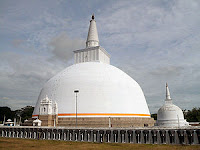Next came the heretic king Mahasena (274 - 301 A.D.). He alienated to the Abhayagiri vast spoil from the Maha Monastery, Devanampiya Tissa’s original foundation. But he had more substantial claim to notability than his heresy; not only did he build (for the heretics) Sri Lanka’s vastest completed Dagaba the Jetavana Ramaya, - but he was also the greatest irrigator of the Sinhala Kings, building 16 major tanks and a great canal.
Anuradhapura was to continue for six hundred years longer as the national capital. But as the protecting wilderness round it diminished with prosperity, and internecine struggles for the royal succession grew, it became more and more vulnerable to the pressures of South Indian expansion. The final blow came when the Chola King Rajaraja I invaded Sri Lanka, burnt and looted the city. Anuradhapura was finally abandoned and the Capital withdrawn to more secluded fastness.
But the monuments of its heyday survive, surrounded by such beauties as become the past: the solemn umbrage of trees, the silence of cold stone, and the serenity of the sheltering sky.
 8:41 PM
8:41 PM
 Ranga
Ranga










